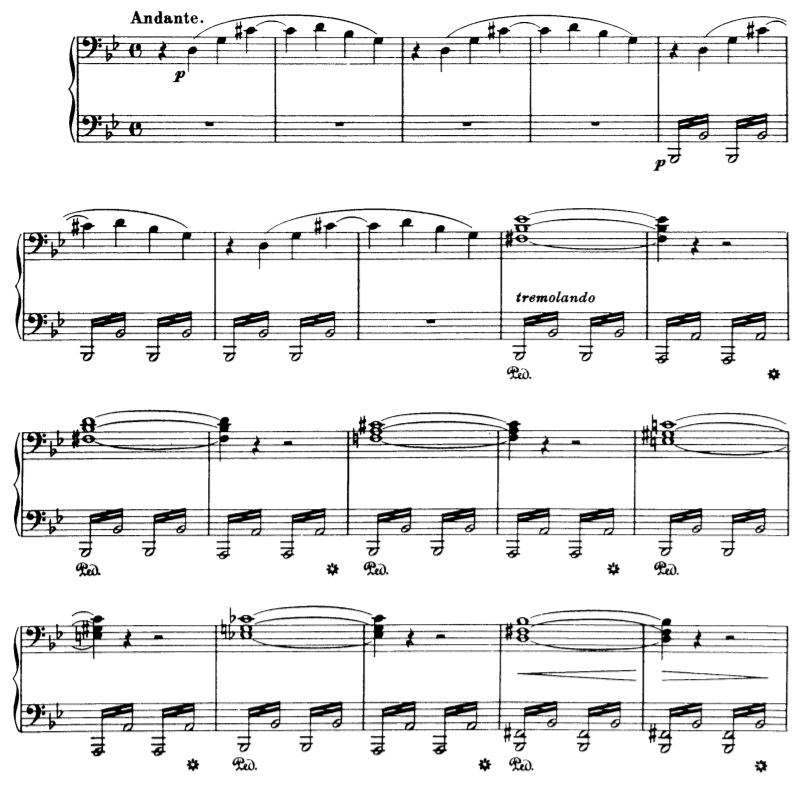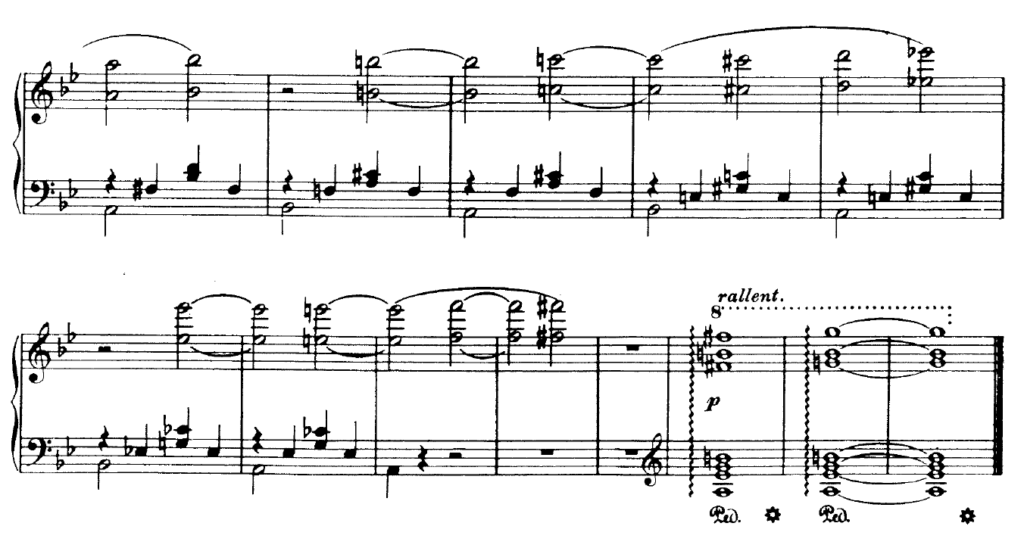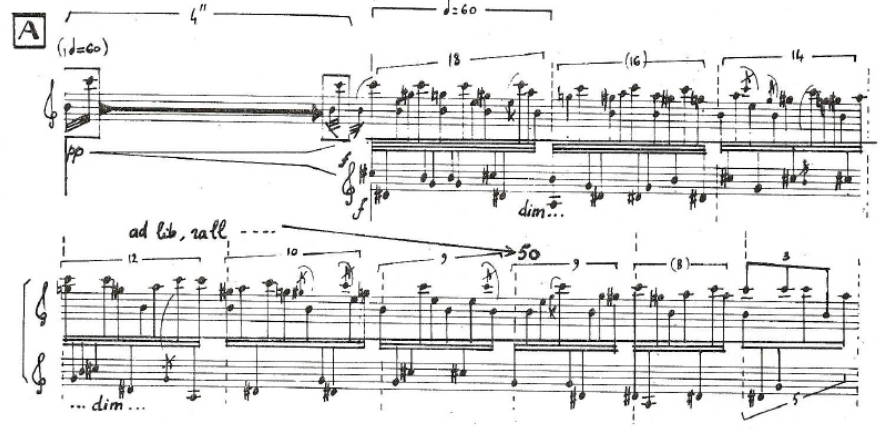Composers Franz Liszt (1811-1886) and Tristan Murail (b. 1947) both departed from compositional standards of their times. Through an exploration of new theories and techniques, these artists forged listening experiences accessible to wide audiences. Two works for solo piano, Liszt’s Nuages Gris, S. 199 (1881) and Murail’s Territoires de l’oubli (1977) represent a breaking of trends, and a closer look at the score reveals more specific artistic bridges. Franz Liszt and Tristan Murail offer a transparency in their genius that invites both the performer and listener to contribute in a relationship with music of new sound worlds.
In overview, Liszt’s departure from techniques of earlier keyboard instruments invited a new freedom in his composing and exploration of genres and outreach, anticipating music of the next generation.
The keyboard’s evolution paralleled a change in playing technique, particularly moving into the 19th Century. Early keyboard instruments like the clavichord and harpsichord used a smaller wood frame and lighter strung strings, ideal for private playing and small ensemble accompaniment (Luizz). Thus, the primary technical consideration for performers was to use finger movements on the keys to vary the sound quality produced on each string. Bartolomeo Cristofori’s pianoforte in the 1700’s offered a new escapement and check system that allowed hammers to strike strings continuously without dampening the sound. While the technique for engaging with the keyboard remained similar to that of the clavichord and harpsichord, pianos began to fluctuate in their tone. For example, Viennese instruments had a more brilliant and clear tone with English instruments offering a more sonorous and larger sound (Davison). Composers like Mozart and Beethoven benefited from an instrument capable of evoking orchestral sonorities and timbral variety through registers (Met). The Errand pianos that Liszt used would offer a larger soundboard and heavier hammers, as well as a new pedal system, achieving a balance between power and clarity (Davison). In general, as the piano became more versatile in its sound capabilities, artists like Liszt moved away from the “quiet arm, fingers only” tradition of earlier keyboard playing towards a legato and cantabile touch that employed the wrist and arm (Davison). While pianists of the day maintained slightly varying ideas on technique, it was clear that Liszt had a more holistic goal in mind, that his facility would provide no limitations in his playing of this new instrument (Katsenelson). Interestingly, while Liszt was known for theatrical raising of his arms during a performance, many students commented that his teaching came back to an economical and fluid maneuvering of the keys (Davison). This may indicate that Liszt’s visualization of technique was a tool to mark moments of wonder for an audience, helping them to “perceive the reality of sound in space” and “exchange of energies” (Nonken). It was clear that Liszt’s technique made possible a new creative prerogative.
While Liszt’s facility offered a new command at the keyboard, his ingenuity in composition and artistry in performance practice were most effective in immersing audiences. As one source notes, “his was not virtuosity for the sake of spectacle, but virtuosity deployed as a means towards sound-generation and a dramatic end” (Nonken). Training from Czerny and Salieri provided Liszt a foundation in theory and classical form, though Liszt strove to expand his use of these concepts at the piano, practicing scales, arpeggios and transposition (Bach Cantatas). Liszt routinely transcribed works from orchestra settings to the piano, capturing thicker textures and diverse sonorities. Moreover, Liszt presented vast amounts of solo repertoire in concert, from Bach to Chopin and of course his own works (Inaba). This plethora of material and playing time rewarded Liszt with prowess as both an interpreter and performer. Not only was this vast dissemination of material a novelty, but it set the stage for a solo recital that featured just one instrument. With an angling of the piano lid to project sound fully to audiences, memorization, manipulation, additions and improvisation of ideas, among others, Liszt navigated his performance space and audience to create a maximum exposure of music, both past and present that would “evoke and embellish a memory” and enhance the senses (Botstein).
In addition to a new freedom in the use and presentation of music material, Liszt pioneered new genres and mediums to afford audiences an even richer relationship with music. While many of Liszt’s piano works evoke imagery and excitement in listeners, such as his Années de Pèlerinage (1835), his work in Weimar helped him refine a large-scale narrative form, known as a symphonic poem (Biography). Weimar was known as the “spiritual home of German literature” and Liszt’s love of Goethe’s poetry played a role in his conception of more orchestral repertoire that could tell a story (LaVine). Moreover, Liszt’s work as Kapellmeister for the Grand Duke of Weimar offered opportunities to compose and conduct choral works, allowing Liszt a medium to channel his spirituality (LaVine). While other romantic greats like Beethoven certainly explored themes of human struggle, spirituality, imagery and literature, Liszt’s movement away from classical structures to larger narrative forms allowed him more flexibility in exploiting the full potential of both the orchestra and keyboard to craft musical experiences. This transformation of material through an organic framework allowed audiences to acknowledge their innate reactions to the experience, rather than analyzing and organizing of information characteristic of absolute music.
Accompanied by pianist André Laplante’s recording, a brief look at Liszt’s Nuages Gris offers more particular insight to his creative considerations (Musicanth). Failing health and depression provide the backdrop of this late work, and at this time, Liszt was least concerned with the technical range of his works but more so the expressive implications. As a compromise of both old and new compositional traditions, we see a simple ABA form with a theme throughout, infused with dissonant intervals, meandering chromaticism and feelings of atonality. More specifically, the opening measures showcase a tritone interval, equally separating the octave to soften tonic and dominant tonality. Additionally, the tremolos introduced in measure 5 soon step from Bb to A with a held pedal, creating an emanating dissonance that provides an atmosphere of angst and further blurs the feeling of strong tonality. Finally, Liszt’s use of augmented modulating triads creates a more improvised unfolding of sonority, anticipating an expanded tonality of impressionism. In aggregate, we feel a great interaction with the sound unfolding through time rather than with thematic material and form. Indeed, the title of the work indicates a freedom for listeners to attribute images of rolling clouds to the sound they hear. Noteworthy is the ascending chromatic figures and confused tonality that close the piece, further empowering listeners to derive an experience from the sound’s mingling and existence in their presence, rather than being forced to analyze form or thematic material.
Nuages Gris, Ex. 1 showing the opening page:
Nuages Gris, Ex. 2 showing the final measures:
As history reflects on Liszt’s creativity and ushering of new genres, we also celebrate his willingness to nurture the community in other forms of outreach. This includes the funding of music festivals and schools, teaching and performing free of charge, encouraging premieres of new works and writing extensively on music and composers (Humphrey).
Like Liszt, Tristan Murail follows a similar pathway of departures, forging of new creative approaches, all the while embracing a transparency and inclusiveness in dissemination of musical knowledge and experience.
In the 1970s, composer Tristan Murail worked to layout the theory and technique of the spectral movement, envisioning sound as “plasma” or “spectra” that could be crafted into music (Griffiths). In general, these artists wanted to move away from “structuralist trends” of serialism (Smith). As one source notes, the excessive focus on an input of notes, in works such as Stockhausen’s Klavierstücke created an inorganic flow of sound (Anderson). Murail felt that the serial agenda was hampering music’s capacity to express humanity and welcome listeners. As one source clarifies, Murail felt that “form of the music is simply the evolution of its material” and in addition to exploring a new sound world characterized by decay and resonance, he would employ use of rest, stability, tonal continuity and aggregation into his works, appealing to wider audiences (Anderson). Like Liszt, Murail hoped to wield sound in new ways, but through a proficiency in his new compositional process, continue to place value in the musical experience. As one source aptly summarizes, “techniques and theories remain subordinate to aural sense and poetic impulse” (Anderson).
Like Liszt, Murail’s journey to master new techniques was a means to reflect freedom in composition and form. Paralleling the formation of IRCAM, or the Institute for Research and Coordination in Acoustics/Music, Murail began exploring new technology in his writing. One technique included using ring and frequency modulators that could produce sounds “halfway between harmony and timbre” (Anderson). As we hear in Gondwana for Orchestra (1980) recorded live by the Orchestre National de France, Murail creates main tones, humming tones and higher than normal frequencies (Loy). This sensation of white noise further casts listeners’ senses into the story’s sound world, unifying the technological and extramusical components. Another novel technique is the use of taped sound to be played alongside other acoustic or electrical instruments (Smith). While this offers a performance challenge of staying in time with the recorded material, the overall texture of the sound can become more multidimensional, like a living entity. Philip Meade’s recording of Tombeau de Messiaen (1994) illustrates a similar approach by Jonathan Harvey to integrate taped and live sound in a performance (Wellesz Opus). In navigating a performance space, Murail was able to tune recorded sounds to better match instruments in the ensemble, or even alter the amplification of the recording to better match the acoustics of the performance venue (Smith). Like Liszt’s modifications to his performance space and projection of the piano, these considerations help to put a priority on the listener’s experience and access to the sound world. Moreover, both composers strive to integrate compositional processes with the musical results, creating an accessible format for listeners.
Murail’s Territoires de l’oubli offers insight into bridges between new and familiar practices that appeal to a performer tackling this new sound world. Like Liszt, Murail strives to use an idea to its fullest potential. As we hear in pianist Marilyn Nonken’s performance, a basic idea greets the listener and continues to develop and transform through the duration of the work, aided by a continuous pedal (Nonken). One source notes, there is a challenge in practicing the material, which is often thick in texture and lacking a regular meter (Fried). However, Murail attempts to help the performer navigate these structures. One example is that tempi changes are notated as both spatial, with closeness of figures indicating faster sound, as well as with traditional rhythmic notation. Moreover, polyrhythms, while written out, often do not coincide between the hands, due to differences in tempi. Therefore, Murail encourages the performer to practice for specificity, only as a means to realize the larger musical gestalt (Fried). As such, while performers learn to engage with notation in spectral compositions, Murail also is humble in making compromises between traditional and new practice approaches. In this way, Murail’s direct collaboration with performers informs him of how to notate spectral ideas in the most effective way, always placing a priority back on the expressive capacity of the sound world. In the opening bars of the piece below, we can see these moments of spatial notation and polyrhythms that begin developing the main idea.
Territoires de l’oubli, Ex. 3 showing the opening bars:
Looking forward, Murail also made strides in his dissemination of technology and teaching. His building of special electronic equipment and instruments, reverb units, analogs, synthesizers and notation software as well as his teaching at IRCAM demonstrate a transparency and grace to his pedagogy, much like Liszt (Smith).
Both Franz Liszt and Tristan Murail seized opportunities to depart from traditional practices. The resulting ingenuity and virtuosity is valued not for the sake of being different, but as a testament to their belief that process and musical experience should coalesce, and that listeners and performers deserve to be functioning contributors in this new sound world.
Works Cited
Davison, Alan. “Franz Liszt and the Development of 19th-Century Pianism: A Re-Reading of the Evidence.” The Musical Times, vol. 147, no. 1896, 2006, pp. 33–43. JSTOR, JSTOR.
NPR Staff. “Franz Liszt At 200: An Important, But Not Great, Composer” Deceptive Cadence. NPR. 21 October 2011. Web. Accessed 16 December 2018.
“Franz Liszt (Composer, Arranger)” Bach Cantatas Website. 14 June 2017. Web. Accessed 15 December 2018.
Biography.com Editors. “Franz Liszt Biography” Biography.com, A&E Television Networks, 27 April 2017. Web. Accessed 15 November 2018.
LaVine, Kevin. “Franz Liszt” Library of Congress. Web. Accessed 15 November 2018.
Inaba, Jean. “How Franz Liszt Changed Concert Performances Forever” Colorado Public Radio. 20 October 2014. Web. Accessed 16 December 2018.
Cooper, Thomas. “Tonal Innovations in Ferenc Liszt’s Earlier Piano Compositions” Hungarian Review. 15 September 2011. Web. Accessed 17 December 2018.
Botstein, Leon. “What Makes Franz Liszt Still Important?” The Public Domain Review. 17 October 2011. Web. Accessed 14 December 2018.
Searle, Humphrey. “Franz Liszt” Encyclopædia Britannica. 18 October 2018. Web. Accessed 16 December 2018.
Platt, Russell. “Liszt List” The New Yorker. 20 June 2011. Web. Accessed 15 December 2018.
Shuangshuang, Xun; Guanghu Bai “From Franz Liszt’s Late Piano Works to Analyze His Music Performing Style” European Centre for Research Training and Development UK. International Journal of Music Studies Vol.1, No.1, May 2016. pp. 23-27.
Li, Mei. “The Key Characteristics of Franz Liszt’s Late Piano Works” Kansas University Scholar Works. 9 April 2018. Web. Accessed 14 December 2018.
Grande, Antonio. “Liszt and Scriabin. A Case of Continuity in some Twentieth-Century Compositional Techniques” 9th European Music Analysis Conference – Euromac 9. 2017. Web. Accessed 17 December 2018.
Tommasini, Anthony. “For Liszt, Experimentation Was a Form of Greatness” The New York Times. 23 August 2011. Web. Accessed 14 December 2018.
Luizz, Luis. “Piano evolution, history of keyboard instruments” YouTube. 11 August 2016. Web. Accessed 16 December 2018.
Libin, Laurence E.; Ripin, Edwin M.; Clutton, Cecil. “Keyboard instrument” Encyclopædia Britannica. 2018. Web. Accessed 16 December 2018.
The Met Editors. “Franz Liszt’s Grand Piano” The Metropolitan Museum of Art. 14 May 2001. Web. Accessed 16 November 2018.
Katsenelson, Vitaliy. “How Franz Liszt Has Revolutionized Piano and Classical Music” Medium. 19 February 2017. Web. Accessed 15 December 2018.
Anderson, Julian, and Tristan Murail. “In Harmony. Julian Anderson Introduces the Music and Ideas of Tristan Murail.” The Musical Times, vol. 134, no. 1804, 1993, pp. 321–323. JSTOR, JSTOR.
Thomas, Gavin. “Tristan Murail” Composition Today. The Rough Guide To Classical Music. 2018. Web. Accessed 17 December 2018.
“Tristan Murail to lecture at Skaņu Mežs, performed by Quatuor Diotima” Skaņu Mežs. 2018. Web. Accessed 18 December 2018.
Smith, Ronald B. “An Interview with Tristan Murail” Computer Music Journal 2000, Vol. 24, 11-19. Doi.org
Guardian Editors. “Tristan Murail’s world of breathtaking, disturbing beauty” The Guardian. 2018. Web. Accessed 17 December 2018.
SACEM Editors. “5 minutes with… Michael Jarrell & Tristan Murail” YouTube. 28 November 2011. Web. Accessed 17 December 2018.
Anderson, Julia. “Territoires de l’oubli” Tristan Murail. Web. Accessed 17 December 2018.
“Murail’s Territoires de l’oubli & Stockhausen’s Klavierstücke” JDP Music Building. 21 October 2017. Web. Accessed 17 December 2018.
Fried, William. “Learning to Perform Murail’s Territoires De L’oubli: Suggestive Content in Synonymous Temporal Musical Notation.” Perspectives of New Music, vol. 52, no. 3, 2014, pp. 69–92. JSTOR, JSTOR
Powers, Wendy. “The Piano: The Pianofortes of Bartolomeo Cristofori (1655–1731)” The Metropolitan Museum of Art. October 2003. Web. Accessed 16 December 2018.
Nonken, Marilyn. The Spectral Piano. Cambridge: Cambridge University Press 2014. Print.
Griffiths, Paul. Modern Music and After, 3rd Edition. New York: Oxford University Press, 2010. Print.
Loy, Steven. “Tristan Murail: Gondwana (1980) for orchestra” YouTube. 1 December 2017. Web. Accessed 17 December 2018.
Wellesz Opus. “Jonathan Harvey: Tombeau de Messiaen (1994)” YouTube. 1 February 2015. Accessed 18 December 2018.
Musicanth. “Liszt – Nuages gris (Trübe Wolken), S. 199 (1881) [André Laplante]” YouTube. 6 June 2011. Web. Accessed 18 December 2018.
Nonken, Marilyn. “Territoires de l’oubli” Murail, T.: Complete Piano Works. 2013 Metier.


